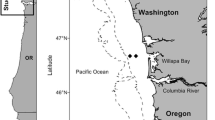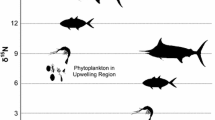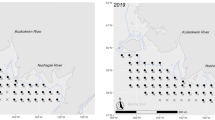Abstract
Increasing interest in the marine trophic dynamics of Pacific salmon has been motivated by the recognition of their sensitivity to changing climate and to the competitive effects of hatchery fish on wild stocks. It has become more common to use stable isotopes to supplement traditional diet studies of salmon in the ocean; however, there have been no integrated syntheses of these data to determine whether stable isotope analyses support the existing conventional wisdom of feeding strategies of the Pacific salmon. We performed a meta-analysis of stable isotope data to examine the extent of trophic partitioning among five species of Pacific salmon during their marine lives. Pink, sockeye, and chum salmon showed very high overlap in resource use and there was no consistent evidence for chum relying on alternative food webs dominated by gelatinous zooplankton. δ15N showed that Chinook and coho salmon fed at trophic levels higher than the other three species. In addition, these two species were distinctly enriched in 13C, suggesting more extensive use of coastal food webs compared to the more depleted (pelagic) signatures of pink, sockeye, and chum salmon. This paper presents the first synthesis of stable isotope work on Pacific salmon and provides δ15N and δ13C values applicable to research on the fate of the marine derived nutrients these organisms transport to freshwater and riparian ecosystems.



Similar content being viewed by others
References
Aydin KY (2000) Trophic feedback and carrying capacity of Pacific salmon (Oncorhynchus spp.) on the high seas in the Gulf of Alaska. PhD dissertation, University of Washington
Aydin KY, McFarlane GA, King JR, Megrey BA, Myers KW (2005) Linking oceanic foodwebs to coastal production and growth rates of Pacific salmon (Oncorhynchus spp.), using models on three scales. Deep Sea Res Pt II 52(5-6):757–780
Beamish RJ, Mahnken C, Neville CM (1997) Hatchery and wild production of Pacific salmon in relation to large-scale, natural shifts in the productivity of the marine environment. ICES J Mar Sci 54(6):1200–1215
Ben-David M (1996) Seasonal diets of mink and martens: effects of spatial and temporal changes in resource abundance. PhD dissertation, University of Alaska, Fairbanks
Bilby RE, Fransen BR, Bisson PA (1996) Incorporation of nitrogen and carbon from spawning coho salmon into the trophic system of small streams: evidence from stable isotopes. Can J Fish Aquat Sci 53(1):164–173. doi:10.1139/cjfas-53-1-164
Brodeur RD (1990) A synthesis of the food habits and feeding ecology of salmonids in marine waters of the north Pacific. FRI-UW-9016, Fisheries Research Institute, University of Washington, Seattle, USA, pp 38
Brodeur RD, Pearcy WG (1992) Effects of environmental variability on trophic interactions and food web structure in a pelagic upwelling ecosystem. Mar Ecol Prog Ser 84(2):101–119. doi:10.3354/meps084101
Brodeur RD, Sugisaki H, Hunt GL Jr (2002) Increases in jellyfish biomass in the Bering Sea: implications for the ecosystem. Mar Ecol Prog Ser 233:89–103. doi:10.3354/meps233089
Bugaev VF, Welch DW, Selifonov MM, Grachev LE, Eveson JP (2001) Influence of the marine abundance of pink salmon (Oncorhynchus gorbuscha) and sockeye salmon (O. nerka) on growth of Ozernaya River sockeye. Fish Oceanogr 10(1):26–32. doi:10.1046/j.1365-2419.2001.00150.x
Burgner RL, Light TJ, Margolis L, Okazaki T, Tautz A, Ito S (1992) Distributions and origins of steelhead trout (Oncorhynchus mykiss) in offshore waters of the North Pacific Ocean. In: Int North Pac Fish Comm Bull, vol 51
Cabana G, Rasmussen JB (1996) Comparison of aquatic food chains using stable nitrogen isotopes. Proc Natl Acad Sci USA 93(20):10844–10847. doi:10.1073/pnas.93.20.10844
Chaloner DT, Martin KM, Wipfli MS, Ostrom PH, Lamberti GA (2002) Marine carbon and nitrogen in southeastern Alaska stream food webs: evidence from artificial and natural streams. Can J Fish Aquat Sci 59(8):1257–1265. doi:10.1139/f02-084
Cooney RT, Brodeur RD (1998) Carrying capacity and North Pacific salmon production: stock-enhancement implications. Bull Mar Sci 62(2):443–464
Cooper H, Hedges LV (1994) Handbook of research synthesis. Russell Sage Foundation, New York
Davenport SR, Bax NJ (2000) A trophic study of a marine ecosystem off southeastern Australia using stable isotopes of carbon and nitrogen. Can J Fish Aquat Sci 59:514–530. doi:10.1139/f02-031
Davis ND (2003) Feeding ecology of Pacific salmon (Oncorhynchus spp.) in the central North Pacific Ocean and central Bering Sea, 1991–2000. Ph.D. dissertation, Hokkaido University, Hakodate, Japan
Davis ND, Takahashi M, Ishida Y (1996) The 1996 Japan–U.S. cooperative high-seas salmon research cruise of the Wakatake maru and a summary if 1991–1996 results. In: North Pac Anadr Fish Comm Doc. 194. FRI-UW-9617. Fish Res Inst, University of Washington, Seattle, 45 pp
Duggins DO, Simenstad CA, Estes JA (1989) Magnification of secondary production by kelp detritus in coastal marine ecosystems. Science 245(4914):170–173. doi:10.1126/science.245.4914.170
France RL (1995) Carbon-13 enrichment in benthic compared to planktonic algae: foodweb implications. Mar Ecol Prog Ser 124(1-3):307–312. doi:10.3354/meps124307
Fry B (1981) Natural carbon stable-isotope tag traces Texas shrimp migrations. Fish Bull US 79:337–345
Fry B, Sherr EB (1984) Delta-C-13 measurements as indicators of carbon flow in marine and fresh-water ecosystems. Contrib Mar Sci 27:13–47
Gearing NG (1991) The study of diet and trophic relationships through natural abundance of 13C. In: Coleman DC, Fry B (eds) Carbon isotope techniques. Harcourt (Brace Jovanovich), New York
Gende SM, Edwards RT, Willson MF, Wipfli MS (2002) Pacific salmon in aquatic and terrestrial ecosystems. Bioscience 52(10):917–928. doi:10.1641/0006-3568(2002)052[0917:PSIAAT]2.0.CO;2
Godfrey H, Henry KA, Machidori S (1975) Distribution and abundance of coho salmon in offshore waters of the North Pacific Ocean. In: Int North Pac Fish Comm Bull, vol 31. Vancouver, BC, Canada
Groot C, Margolis L (eds) (1991) Pacific salmon life histories. University of British Columbia Press, Vancouver
Hare SR, Francis RC (1995) Climate change and salmon production in the northeast Pacific Ocean. In: Beamish RJ (ed) Climate change and northern fish populations, pp 357–372. Can Spec Publ Fish Aquat Sci, p 121
Hilborn R, Quinn TP, Schindler DE, Rogers DE (2003) Biocomplexity and fisheries sustainability. Proc Natl Acad Sci USA 100(11):6564–6568. doi:10.1073/pnas.1037274100
Hobson KA (1999) Tracing origins and migration of wildlife using stable isotopes: a review. Oecologia 120:314–326. doi:10.1007/s004420050865
Hobson KA, Clark RG (1992) Assessing avian diets using stable isotopes I: turnover of 13C in tissues. Condor 94:181–188. doi:10.2307/1368807
Hobson KA, Piatt JF, Pitocchelli J (1994) Using stable isotopes to determine seabird trophic relationships. J Anim Ecol 63(4):786–798. doi:10.2307/5256
Jennings S, Renones O, Morales-Nin B, Polunin NVC, Moranta J, Coll J (1997) Spatial variation in the 15N and 13C stable-isotope composition of plants, invertebrates and fishes on Mediterranean reefs: implications for the study of trophic pathways. Mar Ecol Prog Ser 146:109–116. doi:10.3354/meps146109
Kaeriyama M, Nakamura M, Yamaguchi M, Ueda H, Anma G, Takagi S, Aydin KY, Walker RV, Myers KW (2000) Feeding ecology of sockeye and pink salmon in the Gulf of Alaska. North Pac Anadr Fish Comm Bull 2:55–63
Kaeriyama M, Nakamura M, Edpalina R, Bower JR, Yamaguchi H, Walker RV, Myers KW (2004) Change in feeding ecology and trophic dynamics of Pacific salmon (Oncorhynchus spp.) in the central Gulf of Alaska in relation to climate events. Fish Oceanogr 13(3):197–207. doi:10.1111/j.1365-2419.2004.00286.x
Kline TC (1999) Temporal and spatial variability of 13C/12C and 15N/14N in pelagic biota of Prince William Sound, Alaska. Can J Aquat Fish Sci 56 (Suppl 1):94–117. doi:10.1139/cjfas-56-S1-94
Kline TC, Boldt JL, Farley EV, Haldorson LJ, Helle JH (2008) Pink salmon (Oncorhynchus gorbuscha) marine survival rates reflect early marine carbon source dependency. Prog Oceanogr 77:194–202. doi:10.1016/j.pocean.2008.03.006
LeBrasseur RJ (1966) Stomach contents of salmon and steelhead trout in the northeastern Pacific Ocean. J Fish Res Board Can 23(1):85–100
Lusseau SM, Wing SR (2006) Importance of local production versus pelagic subsidies in the diet of an isolated population of bottlenose dolphins Tursiops sp. Mar Ecol Prog Ser 321:283–293. doi:10.3354/meps321283
Mantua NJ, Hare SR, Zhang Y, Wallace JM, Francis RC (1997) A Pacific interdecadal climate oscillation with impacts on salmon production. Bull Am Meteorol Soc 78(6):1069–1079. doi :10.1175/1520-0477(1997)078<1069:APICOW>2.0.CO;2
Marcoux M, Whitehead H, Rendell L (2007) Sperm whale feeding variation by location, year, social group and clan: evidence from stable isotopes. Mar Ecol Prog Ser 333:309–314. doi:10.3354/meps333309
Margolis L, Cleaver FC, Fukuda Y, Godfrey H (1966) Salmon of the North Pacific Ocean. VI: Sockeye salmon in offshore waters. In: Int North Pac Fish Comm Bull, vol 20. Vancouver, BC, Canada
McConnaughey T (1978) Ecosystems naturally labeled with carbon-13: applications to the study of consumer food webs. MS Thesis, University of Alaska, Fairbanks, 127 pp
McConnaughey T, McRoy CP (1979) Food-web structure and the fractionation of carbon isotopes in the Bering Sea. Mar Biol (Berl) 53(3):257–262. doi:10.1007/BF00952434
Minagawa M, Wada E (1984) Stepwise enrichment of δ15N along food chains: further evidence and the relationship between δ15N and animal age. Geochim Cosmochim Acta 48(5):1135–1140. doi:10.1016/0016-7037(84)90204-7
Myers KW, Aydin KY, Walker RV, Fowler S, Dahlberg ML (1996) Known ocean ranges of stocks of Pacific salmon and steelhead as shown by tagging experiments, 1956–1995. University of Washington, School of Fisheries, Fish Res Inst, FRI-UW-9614. Seattle, p 229
Naiman RJ, Bilby RE, Schindler DE, Helfield JM (2002) Pacific salmon, nutrients, and the dynamics of freshwater and riparian ecosystems. Ecosystems (N.Y., Print) 5(4):399–417. doi:10.1007/s10021-001-0083-3
Pearcy WG (1992) Ocean ecology of North Pacific salmonids. Washington Sea Grant Program. University of Washington Press, Seattle
Pearcy WG, Brodeur JM, Shenker JM, Smoker WW, Endo Y (1988) Food habits of Pacific salmon and steelhead trout, midwater trawl catches and oceanographic conditions in the Gulf of Alaska 1980–1985. Bull Oceanogr Res Inst 26:29–78
Peterman RM, Pyper BJ, Lapointe MF, Adkison MD, Walters CJ (1998) Patterns of covariation in survival rates of British Columbian and Alaskan sockeye salmon (Oncorhynchus nerka) stocks. Can J Fish Aquat Sci 55:2503–2517. doi:10.1139/cjfas-55-11-2503
Peterson BJ, Fry B (1987) Stable isotopes in ecosystem studies. Annu Rev Ecol Syst 18:293–320. doi:10.1146/annurev.es.18.110187.001453
Piorkowski RJ (1995) Ecological effects of spawning salmon on several southcentral Alaskan streams. PhD dissertation. University of Alaska, Fairbanks
Post DM, Layman CA, Arrington DA, Takimoto G, Quattrochi J, Montana CG (2007) Getting to the fat of the matter: models, methods and assumptions for dealing with lipids in stable-isotope analyses. Oecologia 152(1):179–189. doi:10.1007/s00442-006-0630-x
Quinn TP (2005) The behavior and ecology of Pacific salmon and trout. University of Washington Press, Seattle
Ruggerone GT, Nielsen JL (2004) Evidence for competitive dominance of pink salmon (Oncorhynchus gorbuscha) over other salmonids in the North Pacific. Rev Fish Biol Fish 14(3):371–390. doi:10.1007/s11160-004-6927-0
Ruggerone GT, Zimmerman M, Myers KW, Nielsen JL, Rogers DE (2003) Competition between Asian pink salmon (Oncorhynchus gorbuscha) and Alaskan sockeye salmon (O. nerka) in the North Pacific Ocean. Fish Oceanogr 12(3):209–219. doi:10.1046/j.1365-2419.2003.00239.x
Satterfield FR, Finney BP (2002) Stable-isotope analysis of Pacific salmon: insight into trophic status and oceanographic conditions over the last 30 years. Prog Oceanogr 53(2-4):231–246. doi:10.1016/S0079-6611(02)00032-0
Schell DM, Barnett BA, Vinette KA (1998) Carbon and nitrogen isotope ratios in zooplankton of the Bering, Chukchi, and Beaufort seas. Mar Ecol Prog Ser 162:11–23. doi:10.3354/meps162011
Schindler DE, Scheuerell MD, Moore JW, Gende SM, Francis TB, Palen WJ (2003) Pacific salmon and the ecology of coastal ecosystems. Front Ecol Environ 1(1):31–37
Sherwood GD, Rose GA (2007) Stable-isotope analysis of some representative fish and invertebrates of the Newfoundland and Labrador continental shelf food web. Estuar Coast Shelf Sci 63:537–549. doi:10.1016/j.ecss.2004.12.010
Sinisalo TE, Valtonen T, Helle E, Jones RI (2006) Combining stable isotope and intestinal parasite information to evaluate dietary differences between individual ringed seals (Phoca hispida botnica). Can J Zool 84:823–831. doi:10.1139/Z06-067
Sokal RR, Rohlf FJ (1981) Biometry, 2nd edn. Freeman, New York
Tadokoro K, Ishida Y, Davis ND, Ueyanagi S, Sugimoto T (1996) Change in chum salmon (Oncorhynchus keta) stomach contents associated with fluctuations of pink salmon (O. gorbuscha) abundance in the central subarctic Pacific and Bering Sea. Fish Oceanogr 5(2):89–99. doi:10.1111/j.1365-2419.1996.tb00108.x
Thomas CJ, Cahoon LB (1993) Stable-isotope analyses differentiate between different trophic pathways supporting rocky-reef fishes. Mar Ecol Prog Ser 95:19–24. doi:10.3354/meps095019
Tieszen LL, Boutton TW, Tesdahl KG, Slade NA (1983) Fractionation and turnover of stable carbon isotopes in animal issue: implications for δ13C analysis of diet. Oecologia 57(1-2):32–37. doi:10.1007/BF00379558
Tucker S, Bowen WD, Iverson SJ (2007) Dimensions of diet segregation in grey seals Halichoerus grypus revealed through stable isotopes of carbon (δ13C) and nitrogen (δ15N). Mar Ecol Prog Ser 339:271–282. doi:10.3354/meps339271
Vander Zanden MJ, Rasmussen JB (1999) Primary consumer δ15N and δ13C and the trophic position of aquatic consumers. Ecology 80(4):1395–1404. doi:10.1890/0012-9658(1999)080[1395:PCCANA]2.0.CO;2
Vander Zanden MJ, Rasmussen JB (2001) Variation in 15N and 13C trophic fractionation: implications for aquatic food web studies. Limnol Oceanogr 46(8):2061–2066
Wada E, Terazaki M, Kabaya Y, Nemoto T (1987) 15N and 13C abundances in the Antarctic Ocean with emphasis on the biogeochemical structure of the food web. Deep Sea Res 34(5-6):829–841. doi:10.1016/0198-0149(87)90039-2
Walker RV, Myers KW (1998) Growth studies from 1956–1995 collections of pink and chum salmon scales in the central North Pacific Ocean. North Pac Anadr Fish Comm Bull 1:54–65
Welch DW, Parsons TR (1993) 13C and 15N values as indicators of trophic position and competitive overlap for Pacific salmon (Oncorhynchus spp.). Fish Oceanogr 2:11–23. doi:10.1111/j.1365-2419.1993.tb00008.x
Zaporozhets OM, Zaporozhets GV (2004) Interaction between hatchery and wild Pacific salmon in the Far East of Russia: a review. Rev Fish Biol Fish 14(3):305–319. doi:10.1007/s11160-005-3583-y
Acknowledgments
This work is a contribution of the University of Washington Alaska Salmon Program, funded by the National Science Foundation (Biological Oceanography, Biocomplexity), the Gordon and Betty Moore Foundation, the Alaska salmon processors, and the University of Washington. We thank G. Holtgrieve, J. Moore, W. Palen, L. Rogers, M. Winder, P. Westley, and J. Wittouck for assistance in obtaining salmon tissue samples, T. Essington for analytical assistance, N. Davis for comments on earlier manuscript drafts, and J. Carter and C. Ruff for assistance in sample preparation.
Author information
Authors and Affiliations
Corresponding author
About this article
Cite this article
Johnson, S.P., Schindler, D.E. Trophic ecology of Pacific salmon (Oncorhynchus spp.) in the ocean: a synthesis of stable isotope research. Ecol Res 24, 855–863 (2009). https://doi.org/10.1007/s11284-008-0559-0
Received:
Accepted:
Published:
Issue Date:
DOI: https://doi.org/10.1007/s11284-008-0559-0




